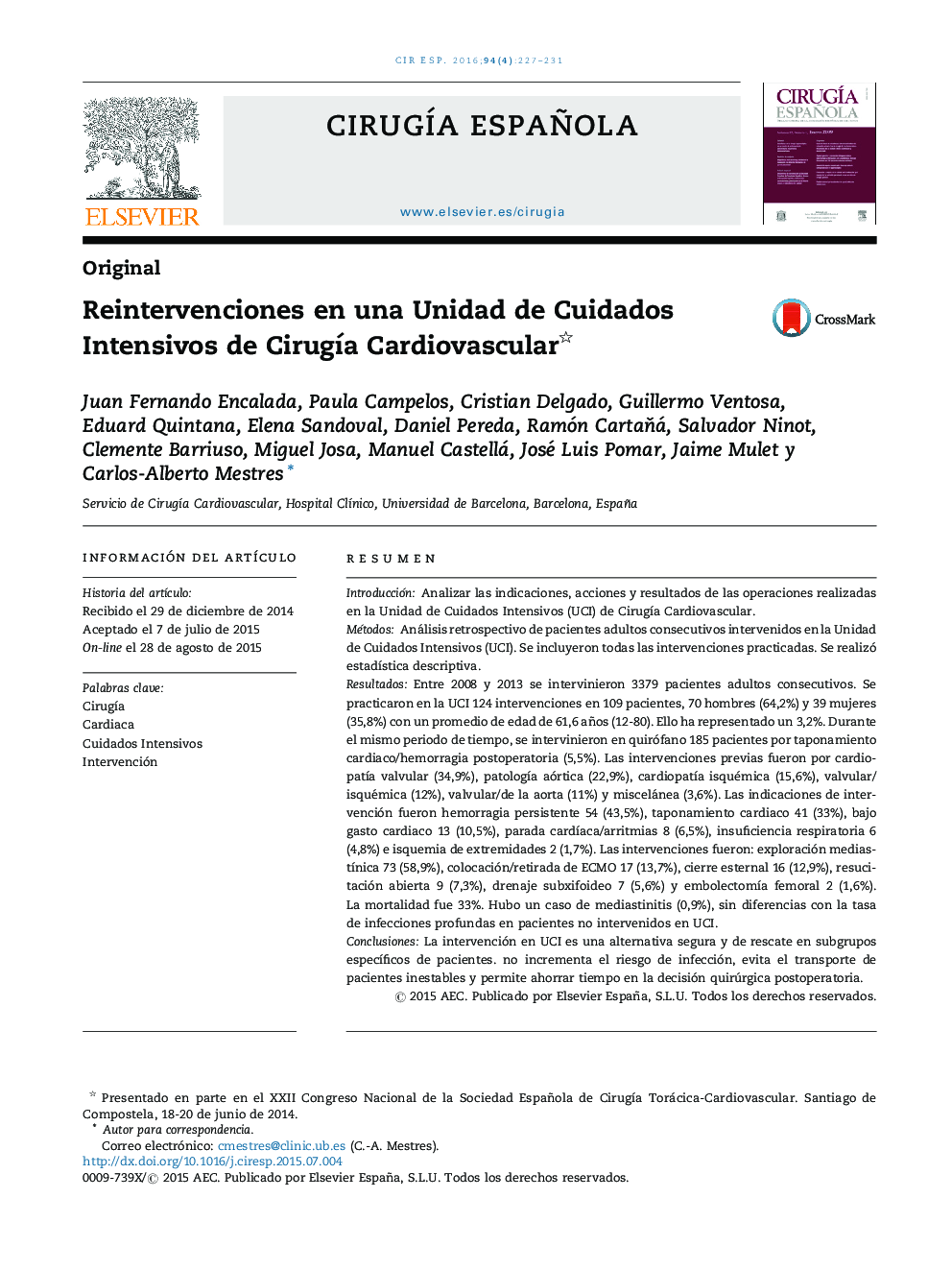| Article ID | Journal | Published Year | Pages | File Type |
|---|---|---|---|---|
| 4252156 | Cirugía Española | 2016 | 5 Pages |
ResumenIntroducciónAnalizar las indicaciones, acciones y resultados de las operaciones realizadas en la Unidad de Cuidados Intensivos (UCI) de Cirugía Cardiovascular.MétodosAnálisis retrospectivo de pacientes adultos consecutivos intervenidos en la Unidad de Cuidados Intensivos (UCI). Se incluyeron todas las intervenciones practicadas. Se realizó estadística descriptiva.ResultadosEntre 2008 y 2013 se intervinieron 3379 pacientes adultos consecutivos. Se practicaron en la UCI 124 intervenciones en 109 pacientes, 70 hombres (64,2%) y 39 mujeres (35,8%) con un promedio de edad de 61,6 años (12-80). Ello ha representado un 3,2%. Durante el mismo periodo de tiempo, se intervinieron en quirófano 185 pacientes por taponamiento cardiaco/hemorragia postoperatoria (5,5%). Las intervenciones previas fueron por cardiopatía valvular (34,9%), patología aórtica (22,9%), cardiopatía isquémica (15,6%), valvular/isquémica (12%), valvular/de la aorta (11%) y miscelánea (3,6%). Las indicaciones de intervención fueron hemorragia persistente 54 (43,5%), taponamiento cardiaco 41 (33%), bajo gasto cardiaco 13 (10,5%), parada cardíaca/arritmias 8 (6,5%), insuficiencia respiratoria 6 (4,8%) e isquemia de extremidades 2 (1,7%). Las intervenciones fueron: exploración mediastínica 73 (58,9%), colocación/retirada de ECMO 17 (13,7%), cierre esternal 16 (12,9%), resucitación abierta 9 (7,3%), drenaje subxifoideo 7 (5,6%) y embolectomía femoral 2 (1,6%). La mortalidad fue 33%. Hubo un caso de mediastinitis (0,9%), sin diferencias con la tasa de infecciones profundas en pacientes no intervenidos en UCI.ConclusionesLa intervención en UCI es una alternativa segura y de rescate en subgrupos específicos de pacientes. no incrementa el riesgo de infección, evita el transporte de pacientes inestables y permite ahorrar tiempo en la decisión quirúrgica postoperatoria.
BackgroundTo analyze the indications, actions and results of the operations performed in the Cardiovascular Surgery Intensive Care Unit.MethodsRetrospective analysis of consecutive non-selected adult patients operated in the ICU. All operations were included. Descriptive statistics were used.ResultsBetween 2008 and 2013, 3379 consecutive adult patients were operated upon. A total of 124 operations were performed in the ICU in 109 patients, 70 male (64.2%) and 39 female (35.8%) with a mean age of 61.6 years (12-80). This represented 3.2% of all operations. During the study period, 185 patients (5.5%) were reoperated for postoperative bleeding/tamponade in the operating room. The index interventions were for valvular heart disease (34.9%), aortic disease (22.9%), ischemic heart disease (15.6%), combined valvular/ischemic (12%), valvular/aorta (11%) and miscellaneous (3.6%). The indications for reoperation were persistent bleeding 54 (43.5%), pericardial tamponade 41 (33%), low cardiac output 13 (10.5%), cardiac arrest/arrhythmia 8 (6.5%), respiratory insufficiency 6 (4.8%) and acute ischemic limb 2 (1.7%). Operations performed were: mediastinal exploration 73 (58.9%), implant/removal of ECMO 17 (13.7%), sternal closure 16 (12.9%), open resuscitation 9 (7.3%), subxyphoid drainage 7 (5.6%) and femoral embolectomy 2 (1.6%). Overall mortality was 33%. There was one case of mediastinitis (0,9%), with no difference from patients operated in the regular operating room.ConclusionsOperations in the ICU represent a safe, life-saving alternative in specific subgroups of patients. The risk of wound infection is not increased, unstable patients are not transferred and there is time savings.
